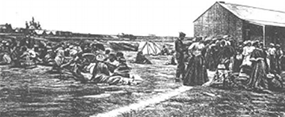After the Jameson invasion, relations between Britain and the ZAR deteriorated. War was imminent and Paul Kruger issued an ultimatum to Britain on 10 October 1899. Stop the build-up of British troops in SA. The ZAR government received no response to the ultimatum. The South African War, also known as the Anglo-Boer War, began. The British soldiers under the command of General A. Hunter took over Krugersdorp in 1900. Without a blow or shot and immediately placed the town under martial law. Conditions in the town were difficult, food was scarce. The movement of residents restricted. Genl. Major Barton of the Gordon Highlanders. He was the commander of the British soldiers during the occupation of Krugersdorp.
The Victorian house with its tower on the corner of De Wet and Begin streets. Known as Kilmarnoch House, it was the headquarters of the British during the war. The house has been well preserved in its original form. It was recently restored. The house is privately owned.

Krugersdorp Commando
The Krugersdorp Commando established in 1898. During the War against Magato and Mpefu in the now Limpopo Province. The Commando recognized during the Anglo-Boer War for its dogged resistance. “The Times History of War in South Africa” describes it as the backbone of the Boer forces, under General De La Rey in the Western Transvaal. In Natal, the Commando was always in the thick of things. It fought a brave rear-guard at Dundee. And served with distinction at Elandslaagte against the Gordon Highlanders. Under the leadership of General Jan Kemp. The Krugersdorp Commando defended its country in the Western Transvaal at the Battles.
Summary of Battles fought in the Cradle – Magaliesberg Area
- Kalkheuwel June 1900 – A column of British Cavalry was ambushed in the Kalkheuwel Pass.
- Dwaarsvlei July 1900 – Krugersdorp Commando attacked the Gordon Highlanders and Royal Horse Artillery
- Silkaatsnek July 1900 – De La Rey defeated a column of Scots Greys at the Battle of Silkaatsnek.
- Olifantsnek July 1900 – Lord Methuen regained control of the town of Rustenburg from surrounding Boer commandos.
- Rietfontein Camp 1900 – 1902 – A major British fortified supply camp depot and hospital in what now a suburb of Ifafi on the banks of Hartbeespoort Dam. The military cemetery remains.
- Buffelspoort December 1900 – General De La Rey and Smuts captured a British convoy of 140 wagons.
- Nooitgedacht December1900 – A major Boer victory by the combined forces of General Beyers, De La Rey and Smuts against General Clement’s column.
- Ebenhaezer 1900 – the Boers raised a stone cairn to celebrate their victory at Nooitgedacht. It was later reconstructed as a commemorative monument.
- Vlakfontein May 1901 – In a vigorous battle, Jan Kemp first captured the British guns at Vlakfontein but was later driven off by the Derbyshire Regiment. The site is now the town of Derby.
- Barton’s Folly 1901 – The last remaining intact masonry built fort in the Magaliesberg. Built by General Barton overlooking the Hekpoort road.
Fort Harleich
Five blockhouses built in Krugersdorp during the British occupation. Only one that has survived is Fort Harleich in Sarel Oosthuizenstraat, Monumentdorp. The blockhouse secured the entrance to the town from Johannesburg. Kept an eye on the Concentration Camp at the foot of the ridge. The blockhouse linked to the Welsh troops. Stationed in Krugersdorp during the Anglo-Boer War.
Krugersdorp Concentration Camp
The Krugersdorp Concentration Camp for women and children. Established in the valley where the Paardekraal Hospital (Yussuf Dadoo Hospital) is today. Know, as Coronation Park.
The concentration camp was the result of the British “scorched earth policy”. Poor, overcrowded housing and meagre food rations led to malnutrition. A lack of household items such as beds and blankets was the order of the day. A nearby fountain and brook supplied the camp and the town with water. By the end of 1901, there were more than 5488 people in the Krugersdorp Concentration camp.

Concentration camp for Black People
Krugersdorp had one of the biggest Refugee Camps for black people. At the end of July 1901, many black people in the northwest region (Western Transvaal). They sought military protection from the ravages of the war. Due to the policy of self-sustainment of Refugee camps. Land cultivation introduced in November 1901. The Krugersdorp Native Refugee Camp moved to the farm Waterval. Due to the availability of water on this farm, it became self-sustaining.


